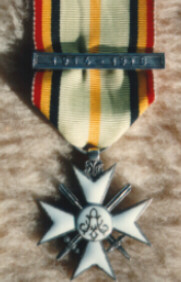

The Civil Decoration 1914-1918
Awarded to civilians or non-combatant military personnel for distinguished service to the country. This decoration, in five classes, was based on the Civil Decoration which had been instituted in 1867. On 18 May 1915 King Albert I instituted the Civil Decoration 1914-1915 whereby the original royal monogram (2 intertwined letters L - King Leopold) was retained owing to the war situation. This 1915 Decoration differed from the 1867 issue on three points : the ribbon, the crossed swords and the bar "1914-1915". A few 1915 Civil Decorations were awarded by the Belgian government, then in exile in the French town of Le Havre. On 12 December 1918 the proper Civil Decoration 1914-1918 was instituted, having the monogram "A" for King Albert and the bar "1914-1918". The five classes, which had remained unchanged throughout the Decoration's life-span, were the 1st and 2nd Class crosses (resp. gold and silver) and the 1st, 2nd and 3rd Class medals (gold, silver and bronze). The crosses, in white enamel and in gilt or silver according to their class, have an identical obverse and reverse, bearing the royal monogram in a central medallion and having crossed swords between the arms. The ribbon is pale green with the Belgian national colours (red, yellow and black) at the edges. A gold thread or yellow central stripe is woven into the ribbon (except for the 1914-1915 version). The medals, in gilt, silver or bronze according to their class, have the space between the cross arms filled in and a Burgundy cross between the arms. Crossed swords are between the medal and its suspension. The ribbon is the same as for the 1st and 2nd Class crosses with the exception of the central stripe. All five classes have a bar "1914-1918" (in the same metal as the cross or medal) on the ribbon.
|
 |
 |
 |
 |
 |
| 1st Class cross, 1914-15 bar | 1st Class cross, 1914-18 bar | 2nd Class Cross, 1914-1918 bar | 2nd Class Medal, 1914-1915 bar | 2nd Class Medal, 1914-1918 bar |
Copyright Hendrik Meersschaert 2024 ©